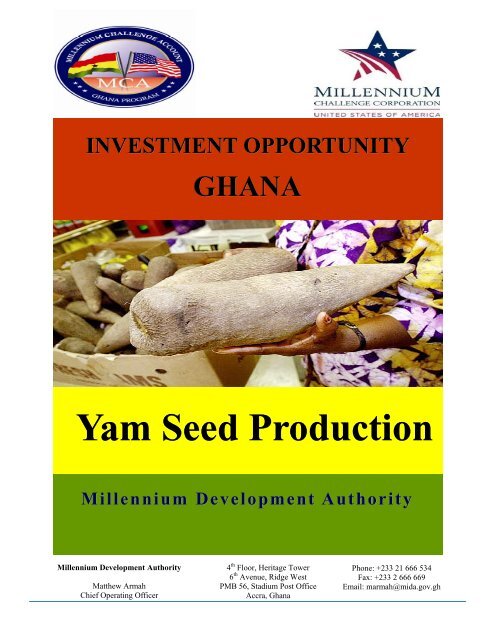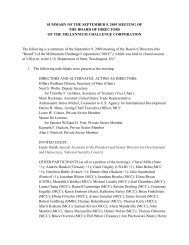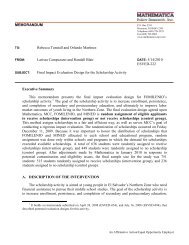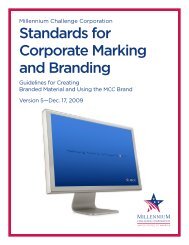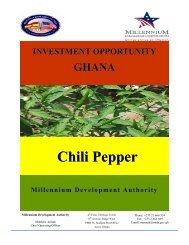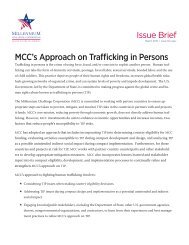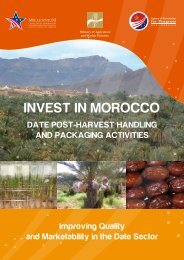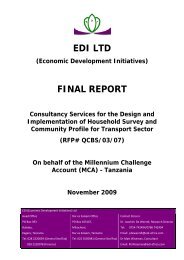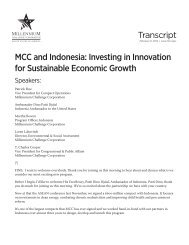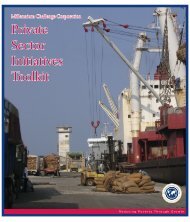Yam Seed Production - Millennium Challenge Corporation
Yam Seed Production - Millennium Challenge Corporation
Yam Seed Production - Millennium Challenge Corporation
Create successful ePaper yourself
Turn your PDF publications into a flip-book with our unique Google optimized e-Paper software.
INVESTMENT OPPORTUNITY<br />
<strong>Millennium</strong> Development Authority<br />
<strong>Millennium</strong> Development Authority<br />
Matthew Armah<br />
Chief Operating Officer<br />
GHANA<br />
<strong>Yam</strong> <strong>Seed</strong> <strong>Production</strong><br />
4 th Floor, Heritage Tower<br />
6 th Avenue, Ridge West<br />
PMB 56, Stadium Post Office<br />
Accra, Ghana<br />
Phone: +233 21 666 534<br />
Fax: +233 2 666 669<br />
Email: marmah@mida.gov.gh
TABLE OF CONTENTS<br />
REASONS TO INVEST IN SEED YAM PRODUCTION IN GHANA 1<br />
BUSINESS OPPORTUNITY SUMMARY 2<br />
YAM PRODUCTION IN GHANA 3<br />
MARKET DYNAMICS 5<br />
SEED YAM PRODUCTION 7<br />
INVESTMENT CLIMATE 9<br />
ANNEX I: YAM PRODUCTION MAP<br />
ANNEX II: COST STRUCTURE<br />
ANNEX III: YAM VALUE CHAIN MAP<br />
ANNEX IV: LAND ACQUISITION<br />
ANNEX V: RESOURCES AND CONTACTS
Page 1<br />
REASONS EASONS TO INVEST NVEST IN<br />
SEED EED YAM AM PRODUCTION RODUCTION IN GHANA HANA<br />
�� Increasing Demand for <strong>Yam</strong><br />
�� Quality and preferred taste of Ghana yam<br />
�� Access to World Markets<br />
�� Good roads, seaports and airports<br />
�� Support of Government<br />
�� Trusted partners in MiDA and ADRA<br />
�� Low labor costs for farm operations<br />
�� Warm and friendly people<br />
�� Politically stable democratic government<br />
�� Positive business enabling environment
BUSINESS OPPORTUNITY SUMMARY<br />
Domestic and foreign investors will find a prime business opportunity in the Commercialization of <strong>Seed</strong><br />
<strong>Yam</strong> <strong>Production</strong>.<br />
Ghana is a leading yam exporter, having exported 20,841 metric tons of yams in 2008, but with<br />
increasing global demand for yams coming from Europe, the U.S. and neighboring African countries,<br />
there is potential for higher production and export volumes. Inadequate access and high cost of seed yam<br />
has prevented producers from expanding the area under yam cultivation, despite the availability of fertile<br />
land and demand for yam domestically and abroad.<br />
<strong>Seed</strong> yam production does not currently exist on a commercial scale in Ghana. An incoming investor<br />
will have the opportunity to lead the development of the market with no competition from other<br />
participants and take advantage of early branding. An investor in seed yam production can begin an<br />
operation using a stock of yam tubers from his or her own production to ensure that yams are high-<br />
quality. The investor can then take advantage of new technologies to increase the quantity of available<br />
seed yam grown from this original stock and can sell seed to farmers. Increased access to seed yam will<br />
allow farmers to increase their production and access niche markets overseas for the globally preferred<br />
Ghana yam, profiting all actors along the value chain.<br />
An investor in Ghana’s growing agribusiness sector will be supported by the <strong>Millennium</strong> Development<br />
Authority (MiDA) and the Adventist Development and Relief Agency (ADRA). MiDA is an agency of<br />
the government of Ghana that is focused on increasing the production and productivity of high-value<br />
cash crops in specific intervention zones, including the Afram Basin where yam is a priority crop.<br />
MiDA’s Agriculture Project includes:<br />
�� Farmer and enterprise trainings to accelerate the development of commercial skills and<br />
capacity among Farmer-Based Organizations (FBOs) and their business partners<br />
�� Land tenure facilitation to ensure tenure security for land users and facilitate access to land for<br />
high-value crops<br />
�� Credit services to increase producers’ and investors’ access to credit for the improvement of<br />
value chain activities<br />
<strong>Millennium</strong> Development Authority (MiDA)<br />
The <strong>Millennium</strong> Development Authority (MiDA) is a Ghanaian public agency, created to implement the programs<br />
pertaining to the “<strong>Millennium</strong> <strong>Challenge</strong> Compact” valued at $547 million and signed in August 2006 between the<br />
Government of Ghana and the Government of the United States. The Compact includes an allocation of $241 million<br />
for an Agriculture Project to increase productivity and $306 million for Transportation and Rural Services Projects<br />
that will complement the strengthening of capacity in the agricultural sector.<br />
MiDA will facilitate investment in this business opportunity for interested domestic and foreign partners, including<br />
access to farmer organizations, community leaders, service providers, government agencies, and other organizations as<br />
necessary.<br />
Page 2
Page 3<br />
YAM PRODUCTION IN GHANA<br />
<strong>Yam</strong> is a important crop in Ghana and is produced throughout most of the<br />
country, as is illustrated by the production map available in Annex I. In fact,<br />
Ghana is the third largest producer of yams in the world, behind Nigeria and<br />
Cote d’Ivoire. Ghana produced approximately 4 million metric tons of yam in<br />
2005, compared to approximately 34 million metric tons produced in Nigeria<br />
and 5 million metric tons produced in Cote d’Ivoire. Following Ghana is Benin,<br />
with a production of about 2.1 million metric tons, and Colombia, Brazil, and<br />
Japan with smaller quantities of production at around 200,000 metric tons in<br />
2005.<br />
<strong>Yam</strong> is an extremely vital crop, not only to the domestic market but also to the export market.<br />
Domestically, it is not only a main source of income, but it is a staple crop vital to food security.<br />
Internationally, customers desire the sweeter taste of the well known “Ghana yam”. Nevertheless, the<br />
lack of planting materials is a major constraint in yam production. <strong>Seed</strong>s are needed to create a more<br />
efficient and affordable growing process that can yield better quality yams.<br />
In Ghana, a variety of yams are grown, but the white yams, especially the Pona (sometimes Puna)<br />
variety, are preferred by both the domestic and export market. Pona is so desirable that it is often<br />
difficult to find enough Pona tubers, especially during June and August, when it is off season. Other<br />
popular varieties include Dente, Asana and Serwaa. The growing cycle for yams ranges from six to eight<br />
months depending on the variety, with planting occurring between February and April, and harvesting<br />
occurring in October.<br />
<strong>Yam</strong>s are grown by small scale farmers using traditional methods for seed generation. This involves<br />
“milking” or harvesting the yam tubers (also known as ware yams) early and using the seed yams that<br />
result from this process for planting. However, this results in a poorer quality, and sometimes diseased,<br />
tubers. Other methods for growing yams include using the yam head or other parts of the yam that can<br />
sprout to produce seeds. The challenge with these techniques is that they do not result in a large number<br />
of yams, and often times, the quality of seeds produced can be poor.<br />
<strong>Yam</strong>s can be planted using the traditional method of using mounds, or the newer method, using ridges.<br />
<strong>Yam</strong>s grown in mounds <strong>Yam</strong>s grown in ridges
With mounds, yams are in rows that are approximately three feet apart, with about 3,500-4,000 mounds per<br />
acre, and can result in about 3,000 tuber or ware yams.<br />
Smaller/slimmer yam<br />
preferred by export<br />
market<br />
Farmers are now adopting the ridging technology instead of using mounds. The<br />
ridging method is preferred because it yields more yams. The ridging technology<br />
maximizes the use of the land, and plants can be planted more closely together (50<br />
cm/1.5 feet apart). With ridges, a farmer can yield about 6,000 yams per acre,<br />
whereas the mounding would have yielded only 3,000 per acre. Ridging not only<br />
results in more yams, but it also generates the smaller/slimmer yams, according to<br />
one farmer based organization, which are preferred by the export market. The<br />
<strong>Millennium</strong> Development Authority (MiDA) is training farmers on working with<br />
this new technology.<br />
Ideal conditions for yam production include annual rainfall of approximately 1,000 mm spread over five to<br />
six months, as well as fertile, well-drained soil. While yams can be cultivated in most regions in Ghana,<br />
most yams are in the middle part of the country. The <strong>Millennium</strong> Development Authority (MiDA) has<br />
trained farmers in parts of these areas, which MiDA has identified as the Afram Basin Zone. The Afram<br />
Basin Zone includes districts from the Eastern region and the Ashanti region.<br />
MiDA Zone Region District 2008 <strong>Production</strong> Yields<br />
(Metric tons)<br />
Afram Basin Eastern Afram Plains 504,400<br />
Afram Basin Ashanti Ejura<br />
Sekyedumasi<br />
142,102<br />
Afram Basin Ashanti Sekyere West 83,692<br />
Afram Basin Ashanti Sekyere East 37,344<br />
Afram Basin Eastern Fanteakwa 20,373<br />
Afram Basin Eastern Kwahu South 16,100<br />
Total 787,911<br />
Total of all yam producing regions 4,894,848<br />
Source: Ghana Ministry of Food & Agriculture 2008 Crop <strong>Production</strong> Data<br />
<strong>Yam</strong> production could be improved if farmers had access to readily available and affordable seed yams.<br />
There are currently not enough affordable seed yams in the market to adequately and efficiently meet the<br />
demand for yams. Additionally, having good quality seed yams can lead to fewer diseased yams.<br />
Page 4
Page 5<br />
MARKET DYNAMICS<br />
Global Demand for Ghanaian <strong>Yam</strong><br />
Ghana is the world’s largest exporter of yams. Ghana is currently exports approximately 21,000 metric<br />
tons of yam annually, a number that has been increasing over the last decade. The compound annual<br />
growth rate of yam exports between 2000 and 2008 is 6.6%.<br />
Source: Ghana Export Promotion Council, 2009<br />
GHANA TOTAL YAM<br />
Year Metric Tons Value USD Value GHC<br />
2000 12,463 7,171,764 10,040,470<br />
2001 14,410 7,785,770 10,900,078<br />
2002 13,025 8,247,906 11,547,068<br />
2003 7,974 4,442,386 6,219,340<br />
2004 16,169 8,339,850 11,675,790<br />
2005 18,377 10,951,354 15,331,896<br />
2006 20,297 14,156,905 19,819,667<br />
2007 19,716 14,551,433 20,372,006<br />
2008 20,842 14,888,801 20,844,321<br />
The United Kingdom imports nearly half of Ghana’s yam exports. Europe represents the largest foreign<br />
market for Ghanaian yam, with the Netherlands, Italy and Germany also importing significant quantities.<br />
The United States is currently importing 18% of exports. Of African countries, Niger imports the largest<br />
quantity of yam from Ghana. Not included in official export numbers are the large quantities of yam that<br />
are transported and sold in nearby countries, including Burkina Faso and Mali that consume but do not<br />
produce yam.<br />
Source: Ghana Export Promotion Council, 2009<br />
Population growth trends and an increase<br />
in international labor migration suggest<br />
that the number of West Africans living<br />
abroad in the coming years will increase.<br />
Rising numbers of Ghanaians have been<br />
migrating to the U.S. and Europe since<br />
the 1990s, according to the International<br />
Organization for Migration. The growing<br />
market abroad for traditional West African<br />
food products such as yam represents<br />
a business opportunity and outlet for<br />
increased production.
Market Price of Ghanaian <strong>Yam</strong><br />
The wholesale price of Ghanaian yam has also been increasing as export quantities increase. Prices have<br />
increased every year between 2000 - when the average monthly price was 21.53 Ghana cedis ($15.20) for<br />
100 tubers (about 250 kilograms) - and 2009, when the average price was 116.30 Ghana cedis ($83.07) for<br />
100 tubers. <strong>Yam</strong> prices are highest in June and July when the most preferred variety of yam, the Pona, is<br />
out of season and in low supply. Farmers are able to get a higher price for other varieties such as Water<br />
<strong>Yam</strong> in June and July relative to other points in the year. Demand is particularly high for quality yam<br />
during the summer months when production is low and exports can command a higher market price.<br />
Price in GH Cedis, 100 Tubers/250 kg<br />
140.00<br />
120.00<br />
100.00<br />
80.00<br />
60.00<br />
40.00<br />
20.00<br />
0.00<br />
GHC 21.53<br />
GHC 35.75<br />
GHC 46.36<br />
GHC 42.00<br />
GHC 66.58<br />
GHC 54.10<br />
GHC 68.50<br />
GHC 81.97<br />
Source: Ministry of Food and Agriculture, 2009<br />
<strong>Yam</strong>s Prepared for Export<br />
Both the farm gate and wholesale prices of Ghanaian yam have been steadily<br />
increasing in recent years, with wholesale prices increasing at a higher rate. As consumers’ willingness to<br />
pay a higher price for yam increases, farmers will increase their production. Local farmers and exporters<br />
indicate a strong willingness to purchase <strong>Seed</strong> <strong>Yam</strong> if it were more readily available. Access to seed yam<br />
would expedite cultivation of yam tubers to meet rising demand.<br />
Price of 100 Tubers, GHCedis<br />
Average Wholesale Prices of <strong>Yam</strong><br />
Ghana, 2000‐2009<br />
GHC 101.26<br />
GHC 116.30<br />
2000 2001 2002 2003 2004 2005 2006 2007 2008 2009<br />
140.00<br />
120.00<br />
100.00<br />
80.00<br />
60.00<br />
40.00<br />
20.00<br />
Price of Ghanaian <strong>Yam</strong>, 2006‐2009<br />
0.00<br />
Source: Ministry of Food and Agriculture, 2009<br />
2006 2007 2008 2009<br />
Farm Gate Price<br />
Wholesale Price<br />
Page 6
Page 7<br />
SEED YAM PRODUCTION<br />
Producing seed yams commercially can fill an important gap and create a niche market in the yam value<br />
chain. As noted above, there is an increasing demand for “Ghana yams”, particularly the White Pona<br />
variety; however, the lack of seed yams limits production capacity. For seed yams that are available, the<br />
cost proves to be prohibitive for most farmers. Most consumers, locally and internationally, prefer the<br />
taste of the Pona yam. Pona seeds, in particular, can be difficult to find since the Pona tuber has a<br />
smaller budding or sprouting area on the tuber itself that can generate seeds.<br />
In Ghana, of all tuber crops, yam is the most preferred and the second most widely cultivated, behind<br />
cassava. <strong>Yam</strong>s are highly desired by consumers in the European markets and American markets,<br />
especially in communities with large numbers of West Africans and Caribbeans. The largest number of<br />
yams is exported to England. Neighboring countries such as Nigeria, Togo and Benin that produce yam<br />
also represent a potential market for seed yam. Like Ghana, these countries do not produce seed yam on a<br />
commercial scale and could benefit from increased access to seed yam and increased production of yam<br />
for export and domestic consumption.<br />
Despite the potential for expansion of yam cultivation, the limited supply and high cost of seed yams is a<br />
major constraint. Though the need is there, the availability is limited. Some farmers use a traditional<br />
process to generate seed yams to circumvent the high costs. They harvest a tuber very early in order to<br />
use it quickly to generate a seed yam. This results in a physiologically immature yam. According to one<br />
yam farmer at a locally based farmer based organization, “Demand for seed yam has gone up at least 50-<br />
60%. People need seed yams more than anything.” Investors will have the opportunity to capitalize on<br />
new technologies and increase the scale of production of seed yams. Techniques has the minisett<br />
technique have been developed and introduced to farmers but have not yet been adopted by commercial<br />
seed growers. Minisett is based on a simple technology whereby one tuber is used to produce multiple<br />
seed yams that lead to the cultivation of healthy tubers. In this technique, one yam tuber can be cut into<br />
approximately 40 pieces, setts, of about 50-100 grams each. The setts are dipped into fungicide and<br />
nematicide which kills any infections already present before planting and prevents disease from<br />
appearing once planted. The yam setts then produce disease free seeds which are ready for harvesting<br />
about five months after planting and used for field planting between February and April the following<br />
year.<br />
<strong>Seed</strong> yam cluster being divided
The seeds can then be sold to farmers to produce tubers or ware yams. In addition to the minisett<br />
technology, the technique of using yam vines to produce seed yams currently being developed by research<br />
institutions, can lead to higher yields of seed yams and higher quality tubers as compared to traditional<br />
methods. Many farmers would be inclined to buy seed yams, rather than plant them themselves, since<br />
planting one’s own seed yams to produce ware yams is time consuming. The entire process could take<br />
almost two years since the farmer would first have to plant the setts to generate the seeds, a process that<br />
takes five months. In the next year, during the new season, the farmer could then use the seed to generate<br />
the ware yam or tuber, a process that can take about eight months. If affordable seeds were readily<br />
available, a farmer could buy them and save him/herself at least five months in the planting cycle.<br />
Since there are currently no commercial seed yam suppliers, an investor can benefit from all the benefits of<br />
being a first mover in the market. The commercial seed yam grower can benefit from access to farmers<br />
who are highly skilled in the newest technologies as well as access to institutions, such as the Crop<br />
Research Institutes, which can supervise farmers and ensure that seeds are produced to the appropriate<br />
standards. The investor would benefit from the lack of competition and would be able to build a strong<br />
brand.<br />
Cutting seed cluster<br />
<strong>Yam</strong> Farmer Based Organization in Mampong<br />
Page 8
INVESTMENT CLIMATE<br />
Ghana’s Economy<br />
�� Ghana is the 2 nd largest economy in West Africa. GDP was<br />
$16.1 billion in 2008 and has been growing at an average annual<br />
rate of 5.4 percent from 2000 to 2007.<br />
�� The population of Ghana is 23.4 million and has been growing<br />
by 2.5 percent per year.<br />
�� Agriculture contributes 54 percent of GDP, accounts for over<br />
40 percent of exports, and provides over 90 percent of the food<br />
needs of the country.<br />
�� The inflation rate has been relatively stable, between 10 and 15 percent per year, for the past 5 years,<br />
except for 2008, where it was 16.5 percent , due to the global food price inflation triggered by rise of<br />
crude oil price. It fell back to 14.5 percent in 2009, and is projected at 9.2 percent in 2010.<br />
�� The exchange rate of the Ghanaian cedi (GH¢) has been stabilized over the past 15 years by strong<br />
management of the Central Bank of Ghana.<br />
Ghana for Doing Business in Agriculture<br />
�� Ghana is ranked #1 in West Africa in “Ease of Doing Business”<br />
according to the International Finance <strong>Corporation</strong>’s Doing Business<br />
2010 Report.<br />
�� Ghana offers a low cost labor supply. The official minimum wage is<br />
3.11 GH¢ per day, although farms typically pay in the range of 3-5<br />
GH¢ per day for agricultural laborers ($2.22-$3.57).<br />
�� Ghana has good port facilities with two commercial ports in Tema and<br />
Takoradi and an international airport in Accra, connecting Ghana to<br />
Europe and the rest of Africa. The road system in Ghana connects<br />
major regional centers to the ports and airports.<br />
�� Ghana has a stable representative democratic government, and has<br />
had fair elections since 1992.<br />
�� The Government of Ghana is committed to increasing private sector<br />
development and agricultural capacity to realize its vision of Ghana as<br />
a prosperous middle-income country by the year 2020. The Food and<br />
Agriculture Sector Development Policy (FASDEP II) includes plans to modernize the agriculture sector<br />
through strengthening value chains, enhancing productivity, improving quality standards, and promoting<br />
public-private partnerships. <strong>Yam</strong> is one of 5 priority crops identified by the Ministry of Food and<br />
Agriculture.<br />
�� The Export Development and Investment Fund (EDIF) <strong>Yam</strong> Initiative can provide financial support to<br />
facilitate the growth of commercial seed yam operations.<br />
Page 9
Foreign investors can have 100 percent ownership in local companies and joint Start-Ups. The minimum<br />
investment requirement is $10,000 for a joint venture, in partnership with a Ghanaian, and $50,000 for a<br />
wholly foreign-owned venture. Investors can also lease land for up to 50 years and have the option to<br />
renew. Other incentives include:<br />
�� Exemption from customs import duties on plant and machinery, equipment and accessories imported<br />
exclusively and especially for establishing enterprises<br />
�� Depreciation or capital allowance of 50 percent in the year of investment and 25 percent in subsequent<br />
years for plant and machinery respectively<br />
�� Full repatriation of earnings in the currency of investment<br />
�� Multilateral Investment Guarantee Agency (MIGA) membership – Ghana’s signature of the World<br />
Bank’s MIGA convention guarantees coverage against non-commercial risks<br />
�� Additional incentives for agro-processing activities, including a 5-year tax holiday from start of<br />
operation and, after 5 years, corporate tax incentive rates fixed according to location<br />
�� Location incentives – After the initial 5-year tax holiday period, agro-processing enterprises that use<br />
local agricultural raw materials as their main inputs will have corporate tax rates based on location:<br />
Accra-Tema – 20 percent, Other Regional Capitals – 10 percent, Outside Regional Capitals – 0 percent,<br />
Throughout Northern, Upper East, Upper West Regions – 0 percent<br />
�� Free Zone Act of 1995: Enterprises that export 70 percent of what they produce may be eligible for:<br />
�� 10-year tax holiday followed by maximum 8 percent corporate tax rate<br />
�� Tax exemption from withholding taxes on dividends<br />
�� Guarantee of unconditional transfer through any authorized dealer bank of dividends, net<br />
profits, payments of loans and other payments<br />
�� Guarantee to be free from nationalization or expropriation by the Ghanaian government<br />
�� Increased Commitment to FDI<br />
FDI Attracted into Key Sectors of the Economy<br />
Year 2008** 2007 2006 2005 2004<br />
No. of Est. Cost of No. of Est. Cost of No. of Est. Cost of No. of Est. Cost of No. of Est. Cost of<br />
Projects Projects (US$) Projects Projects (US$) Projects Projects (US$) Projects Projects (US$) Projects Projects (US$)<br />
Sector<br />
Agriculture 17 57,495,360 15 36,390,309 6 6,451,378 9 4,278,018 9 5,759,297<br />
Building & 26 2,097,913,425 32 38,302,647 20 67,311,769 20 90,232,306 12 15,292,207<br />
Export Trading 19 6,177,535 12 2,052,615 13 9,300,193 8 3,526,260 6 376,067<br />
General 74 836,266,621 67 61,039,048 49 35,936,868 44 34,556,239 33 17,547,349<br />
Liaison 10 9,524,085 10 361,200 18 ‐ 9 ‐ 18 ‐<br />
Manufacturing 50 238,027,314 88 4,826,921,284 63 2,172,783,333 79 37,407,379 52 28,254,916<br />
Services 86 295,088,725 52 54,763,876 68 61,068,029 44 39,715,742 49 97,848,303<br />
Tourism 27 13,475,457 32 9,180,056 19 15,014,910 16 4,022,743 23 40,812,575<br />
Total 309 3,553,968,522 308 5,029,011,035 256 2,367,866,480 229 213,738,687 202 205,890,714<br />
**This excludes the total estimated value of Vodafone International Holding B.V.'s project.<br />
Source: Ghana Investment Promotion Center’s Ghana 100 Magazine<br />
Page 10
Page 11<br />
.ANNEXES<br />
ANNEX I: YAM PRODUCTION MAP<br />
ANNEX II: COST STRUCTURE<br />
ANNEX III: YAM VALUE CHAIN MAP<br />
ANNEX IV: LAND ACQUISITION<br />
ANNEX V: RESOURCES AND CONTACTS
ANNEX I: YAM PRODUCTION IN GHANA, 2003<br />
Source: Crops Research Institute<br />
Page 12
ANNEX II: COST STRUCTURE<br />
It is anticipated that a commercial seed yam grower could generate a profit of 65 percent based on the<br />
assumption that 3,000 yam tubers can be produced on one acre of land, and one seed generates one tuber.<br />
It is further assumed that one sett (cutting) generates six seeds. Under these assumptions, for a one acre<br />
plot of land, 500 setts would be needed to create 3,000 seeds, which in turn, would produce 3,000 tubers.<br />
If the commercial seed yam grower sells each seed for 0.50 Ghana cedis, based on current selling prices in<br />
Ejura, and assuming the cost of each sett used is 0.33 Ghana cedis, a profit of 65 percent can be achieved<br />
after land and planting costs are deducted. Since a commercial seed yam seller would have to get his or<br />
her own “root” stock from his or her own production to ensure that seeds are disease-free, the cost of the<br />
sett to produce the seed is assumed to be the cost of seeds on the open market. The 0.33 Ghana cedis per<br />
sett is the cost of seed yam that sellers incur in Ejura.<br />
*Per oanda.com, exchange rate at 3/31/10, 1Ghana cedi=0.69602 US $<br />
Estimated Revenue<br />
Quantity Price Revenue Ghana cedis Revenue US $<br />
# of <strong>Seed</strong>s 3,000 0.5 1,500 $ 1,044.03<br />
Estimated Cost for 1 acre<br />
Quantity (setts or acre) Per Unit Cost Cost Ghana cedis Revenue US $<br />
Setts 500 0.33 165 $<br />
114.84<br />
Cost of leasing land 1 50 50 $<br />
34.80<br />
Land Clearing (new land) 1 30 30 $<br />
20.88<br />
Land preparation 1 120 120 $<br />
83.52<br />
Planting 1 36 36 $<br />
25.06<br />
Staking 1 12 12 $<br />
8.35<br />
Weeding 1 0 $<br />
‐<br />
‐1st 1 21 21 $<br />
14.62<br />
‐2nd 1 21 21 $<br />
14.62<br />
Harvesting 1 70 70 $<br />
48.72<br />
Total Costs for 1 acre 525 $<br />
365.41<br />
Total Profit for 1 acre 975 $<br />
678.62<br />
Profit Margin for 1 acre 0.65 0.65<br />
It should be noted that in the scenario illustrated above, costs for any specialized machinery for cutting the<br />
setts, related depreciation, or costs for specialized labor are not included. Furthermore, costs for storage,<br />
which are not expected to be high but require good management, are not included. Thus, the resulting<br />
profit margin is anticipated to be lower than illustrated above. Based on interviews with small scale<br />
farmers (who do not use specialized labor or machinery), the profit margin for a seed yam grower is 50<br />
percent.<br />
Costs have been retrieved from the relevant ministries and do not reflect the government’s incentive<br />
programs and tax reductions of which the investor could take advantage.<br />
Page 13
Financing options would be based on an individual assessment of the investor’s own credit risk. In Ghana,<br />
the average lending rate for agricultural projects is 25 percent. However, the Export Development and<br />
Investment Fund (EDIF) has a credit facility that can provide loans of 1.5 percent available to investors in<br />
the export sector and those working in collaboration with local majority-ownership partners.<br />
A selling price of 0.50 Ghana cedis may prove very expensive for a farmer. Assuming that a farmer sells<br />
each tuber for 0.92 Ghana cedis (farm gate price per 2009 MOFA data), he or she will have a profit margin<br />
of 14 percent. MiDA and other programs are working to increase farmers’ access to credit. In addition,<br />
major players in the export market have agreed to document their commitment to purchase greater<br />
quantities of yam from farmers if they can increase their production and meet quality standards.<br />
The following illustrates the revenue and costs for a commercial seed yam producer utilizing 200 acres:<br />
Page 14
ANNEX III: YAM VALUE CHAIN MAP<br />
Retailing<br />
Processsing<br />
Collection<br />
<strong>Production</strong><br />
Inputs<br />
Page 15<br />
Local<br />
Markets<br />
Local<br />
Processsors<br />
Local Markets<br />
and Vendors<br />
Secondary<br />
Bulkers/Regional<br />
Local Traders/<br />
Middlemen<br />
Small/Medium/Large Scale<br />
Input Suppliers<br />
International<br />
Markets<br />
Exporters<br />
Supporting Services<br />
Financial Institutions<br />
Research Institutes<br />
Extension Services
Inputs<br />
The key inputs for the production of yam are seed yam, land, labor, equipment for preparing the land,<br />
staking materials, and agrochemicals. Currently, most yam producers obtain inputs from local markets, but<br />
are constrained by high costs of materials, particularly seed yam, and difficulty in accessing credit. Most<br />
farmers use traditional methods of generating planting materials, which results in lower quality yams. The<br />
minisett technique is used on a small scale and often farmers will keep the seeds that they have produced<br />
rather than sell to others, therefore creating a market opportunity for a commercial seed yam supplier.<br />
<strong>Production</strong><br />
The majority of yam producers in Ghana are smallholder farmers. Steps of the production phase include<br />
clearing the land, preparing mounds or ridges, planting, weeding, staking and harvesting. Much of this is<br />
done by hired labor. The lack of affordable planting material has been the major bottleneck to increased<br />
production.<br />
Collection and Transport<br />
The majority of yam produced is sold on the local market. Traders and middle men transport yams from<br />
the farms to the market. For the export market, there is an opportunity to improve the direct linkages<br />
between producers and exporters. Crop spoilage and loss is a problem that can be addressed by improved<br />
storage facilities.<br />
Processing<br />
Processing of yam takes place on a small scale in Ghana. There is an opportunity to expand processing<br />
facilities and increase the production of fresh yam into other value-added products, such as yam flour,<br />
frozen or dry yam chips, or beverage products.<br />
Retailing<br />
<strong>Yam</strong> is heavily consumed by Ghanaians, who purchase fresh yams at local markets. For external markets,<br />
exporters purchase yams from farmers and transport, normally by ship, to end markets including the<br />
United States, the United Kingdom, and the Netherlands. <strong>Yam</strong> is typically brought to warehouses and<br />
purchased by wholesalers as well as individual consumers. The majority is sold in ethnic markets. The<br />
export market has become the target for increased production.<br />
Financing<br />
Rural banks can supply farmers with credit for the costs of inputs and production, but are often reluctant to<br />
do so because farmers have limited collateral. Major players in the export market have agreed to document<br />
their commitment to purchase greater quantities of yam from farmers if they can increase their production<br />
and meet quality standards. The Export Development and Investment Fund (EDIF) is also a source of<br />
funding for input suppliers and producers of export goods.<br />
Research and Development<br />
The Root and Tuber Improvement and Marketing Program (RTIMP), funded by IFAD (the International<br />
Fund for Agricultural Development) and the Crops Research Institute (CRI) are among the prominent<br />
groups conducting research on the production of yam and seed yam. These organizations support value<br />
chain activities by disseminating their technical know-how.<br />
Extension Services<br />
Extension services that facilitate value-chain activities include technical support from ADRA, MiDA,<br />
RTIMP, CRI, and EDIF. See Resources and Contacts (page 17) for more about how these organizations<br />
can facilitate business opportunities.<br />
Page 16
ANNEX IV: LAND ACQUISITION IN GHANA<br />
Fertile Land and Water Resources<br />
Ghana’s vast tracts of fertile and inexpensive<br />
land with excellent water resources are<br />
attractive to investors interested in acquiring<br />
land for commercial seed yam production.<br />
Given that only 16% of Ghana’s arable land is<br />
currently under agricultural production, there<br />
is significant supply of land resources<br />
available for foreign investors interested in<br />
establishing commercial farm operations.<br />
However, the process for acquiring land can be relatively cumbersome, time-consuming and complex<br />
for outside investors to navigate. Foreigners are permitted to lease land for up to 50 years under a registered<br />
leasehold title. Sample annual rates for leasing an acre of agricultural land range from 10-50 GH¢<br />
($7.15-$35.70) per year.<br />
Types of Land<br />
In Ghana, the Constitution identifies three types of land:<br />
�� Public lands controlled by the state government<br />
�� Stool or skin lands controlled by traditional authorities (chieftaincies) on behalf of communities<br />
�� Family or private lands controlled by individuals or family clans<br />
Foreigners may be able to acquire leasehold interests in public land directly from the government for<br />
very large tracts of land, but public lands represent only 20 percent of land in the country. Family or<br />
The Imprtance of Local Customs<br />
The negotiation process to lease land from traditional authorities can differ from area to area, and in<br />
some cases can involve more than one chieftaincy. It is not uncommon for a representative to act on<br />
behalf of the traditional authority, at least in the initial stages. Following customs and respecting<br />
traditional authorities early in the process can reduce the possibility of misunderstandings or disputes<br />
over land rights as negotiations proceed.<br />
There are often traditional ceremonial protocols to be followed with which foreign investors are<br />
unfamiliar; for example, in many areas, a business person is expected to bring schnapps to the chief<br />
before any request to negotiate for land. It is recommended that investors work through a trusted local<br />
partner, implementing partners and local contacts, to assist in the process to ensure that customs are<br />
followed. An investor who is unfamiliar with these informal, yet very important, processes risks<br />
damaging the opportunity to work with a potentially beneficial partner for the simple lack of knowledge<br />
regarding local customs.<br />
Page 17
MIDA SUPPORT<br />
The highlighted MiDA intervention zones represent areas within Ghana where investors can access<br />
communities with attractive land and water resources and where MiDA and its partners can provide information<br />
on land available for seed yam operations. MiDA and its partners have established relationships<br />
with the traditional<br />
authorities in these areas, as well as the relevant authorities from government entities involved in land<br />
transactions. This enables MiDA and its partners to provide information and facilitate meetings for investors<br />
during the negotiation process. Investors can look to MiDA as a trusted partner available to<br />
help navigate the unfamiliar process of land negotiation in Ghana.<br />
MiDA and its partners will train up to 60,000 farmers in value chain approaches to agricultural production<br />
and assist in the growth and development of farmer-based organizations (FBOs) in these zones.<br />
Farmers participate in six weeks of classroom training on business aspects of farming, FBO organizational<br />
development, and crop planting decisions based on market<br />
dynamics. Farmers also receive three weeks of field training on a specific crop, assisted with a starter<br />
kit of inputs for the chosen crop. The FBOs develop an understanding of the benefits that a commercial<br />
operation can bring to their communities. In many cases, the FBOs act as economic development agents<br />
for their areas. These FBO-trained communities are particularly attractive from the perspective of an<br />
outside<br />
investor interested in a mutually-beneficial relationship with a local community in which to locate operations.<br />
Key Points in Negotiations<br />
Investors should initially focus on ensuring that the land in which they are interested will not be contested by<br />
neighboring families or chieftaincies. Investors or their representatives cannot be seen on the property until<br />
after they have met with the appropriate traditional authorities and the regional council to obtain their blessing<br />
and approval to proceed with exploration of the land and due diligence measures. Because most land available<br />
to investors is fallow, specific boundary lines are not always well established, thus care must be taken to identify<br />
any and all claims at the outset. Investors will also be interested in securing transferable rights and negotiating<br />
leases that are sufficiently long-term to justify the investment necessary to establish commercial operations.<br />
Equally as important as the terms that the investor is seeking are the terms that the investor is willing to<br />
offer to the community. The traditional authorities act as stewards of the land on behalf of the community. As<br />
a result, the negotiation process must involve all stakeholders, including the chiefs, elders, and members of the<br />
community. This helps to ensure that a lease agreement is not challenged in the future for failure to adequately<br />
compensate the community for the use of its resource.<br />
Typically, communities are most interested in a combination of benefits from a commercial operation. In addition<br />
to direct employment opportunities, farmers desire access to better technologies and techniques brought<br />
by a commercial farm. Farmers also value access to machinery for hire, post-harvesting services, and market<br />
linkages from the improvement of transportation services or the direct purchase of product by the commercial<br />
operator. Any investor interested in securing a long-term lease should be willing to enter into a mutuallybeneficial,<br />
long-term arrangement with the local community in order to ensure the best possible opportunity<br />
for success.<br />
Page 18
ANNEX V: RESOURCES AND CONTACTS<br />
<strong>Millennium</strong> Development Authority (MiDA)<br />
Matthew Armah<br />
Chief Operating Officer<br />
4 th Floor, Heritage Tower, 6 th Avenue, Ridge<br />
P.M.B. M.B 56, Ministries, Accra<br />
Tel.: +233 21 666 619<br />
Email: marmah@mida.gov.gh<br />
www.mida.gov.gh<br />
Adventist Development and Relief Agency<br />
(ADRA)<br />
Samuel Asante-Mensah<br />
Project Manager, MiDA Agriculture Project<br />
21 Osu Avenue, Ringway Estate<br />
P.O. Box GP1435, Accra<br />
Tel: +233 21 220 779<br />
Email: asante_mensah@yahoo.com<br />
www.adraghana.org<br />
Ministry of Food and Agriculture (MoFA)<br />
Richard Twumasi-Ankrah<br />
Directorate of Crop Services<br />
P. O. Box M 37<br />
Tel: +233 21 665 066<br />
Email: cropserv@ighmail.com<br />
www.mofa.gov.gh<br />
Ghana Investment Promotion Center<br />
George Aboagye<br />
Chief Executive Officer<br />
P. O. Box M193, Accra<br />
Tel: +233 21 665 125-9/664276<br />
Email: gaboagye@gipcghana.com;<br />
info@gipcghana.com<br />
www.gipcghana.com<br />
Page 19<br />
MiDA is tasked with facilitating investment in this<br />
business opportunity for interested domestic and foreign<br />
investors. MiDA can help investors access farmer<br />
organizations, service providers, government agencies,<br />
and other organizations as needed. It can also provide<br />
more information about its current agriculture, transportation,<br />
and rural development projects that will<br />
complement the establishment of new businesses in<br />
the yam sector.<br />
ADRA is the Regional Implementation Consultant for<br />
the MiDA Agriculture Project in the Afram Basin,<br />
where yam production is high. ADRA can provide<br />
interested investors with direct contact to yam farmer<br />
based organizations as potential clients of the commercial<br />
seed yam investor as well as to exporters of<br />
yam. In partnership with MiDA, ADRA is an important<br />
source of local knowledge.<br />
The Directorate of Crop Services is responsible for<br />
ensuring that adequate planting materials are available<br />
for production. MoFA can provide instruction on integrating<br />
the business investment with government initiatives<br />
and can work with the investor to ensure that<br />
projects in line with national agricultural strategy are<br />
supported. MoFA is also a source of data on all agricultural<br />
products produced in Ghana.<br />
GIPC’s mandate is to coordinate and monitor all investment<br />
activities in Ghana. GIPC will assign an officer<br />
to help an investor with the procedures involved in<br />
land access, incorporating a new business, and other<br />
steps of the decision-making process. GIPC can provide<br />
detailed information about all investment incentives<br />
that Ghana offers.
Export Development and Investment Fund (EDIF)<br />
Frank Obeng<br />
Assistant Director, Export Development and<br />
Promotion<br />
P.O. Box MB 493, Accra<br />
Tel.: +233-21-671-583-4<br />
Email: fkobeng@yahoo.com<br />
www.edifghana.org<br />
Ghana Export Promotion Council (GEPC)<br />
Republic House, Tudu Road<br />
P.P. Box M146. Accra<br />
Tel: +233 21 683 153 / 689 889<br />
Email: info@gepcghana.com<br />
Crops Research Institute (CRI)<br />
Emmanuel Otoo<br />
<strong>Yam</strong> Breeder/Head of <strong>Yam</strong> Program<br />
P.O. Box 3785<br />
Kumasi<br />
Tel: +233 (0) 51 60 389<br />
Email: otooemmanuel@gmail.com<br />
Root and Tuber Improvement and Marketing<br />
Program (RTIMP)<br />
Akwasi Adjei Adjekum<br />
National Program Coordinator<br />
P.O. Box KS 7728<br />
Kumasi<br />
Tel: +233 (0) 51 33 159<br />
Email: rtip@africaonline.com.gh<br />
EDIF can facilitate the development of a seed yam<br />
industry by providing financial support to commercial<br />
seed yam growers. EDIF provides concessionary<br />
resources to farmers and can support investors<br />
through a credit facility. The organization has identified<br />
yam as a target product for export promotion<br />
and has designed a <strong>Yam</strong> <strong>Production</strong> Initiative to<br />
support the development of the sector.<br />
The GEPC provides technical advisory services to<br />
facilitate product and market development. Market<br />
access missions are a core part of organization’s<br />
activities which can help an investor gain information<br />
and penetrate new markets. GEPC also maintains<br />
data on the export of Ghana’s agricultural<br />
products and can disseminate selective trade information.<br />
The CRI is a leading research institute in Ghana,<br />
with staff devoted exclusively to yam and seed yam<br />
production. CRI can provide technical support for<br />
commercial seed yam growers based on up-to-date<br />
research. CRI has been involved in the development<br />
of the minisett technique and continues to develop<br />
improved crop varieties and production technologies.<br />
RTIMP is working in the Ashanti Region on the<br />
improvement of production methods for yam and<br />
other tubers. RTIMP can support investors by linking<br />
them to farmers and organizing the outgrower<br />
scheme, providing technical trainings to farmers,<br />
providing seed inspectors to ensure the high quality<br />
of seed yam produced, liaising with the Ministry of<br />
Food and Agriculture, and providing general consulting.<br />
A publication of the <strong>Millennium</strong> Development Authority (MIDA)<br />
in conjunction with<br />
the United States <strong>Millennium</strong> <strong>Challenge</strong> <strong>Corporation</strong><br />
Page 20
Northern Agricultural<br />
Zone<br />
Savelugu Nanton<br />
Tolon Kumbungu<br />
Tamale<br />
West Mamprusi<br />
Karaga<br />
Afram Basin Zone<br />
Kwahu North<br />
Kwahu South<br />
Kwahu East<br />
Fanteakwa<br />
Akuapem South<br />
Municipal<br />
Yilo Krobo<br />
Upper Manya<br />
Krobo<br />
Lower Manya<br />
Krobo<br />
Sekyere East<br />
Sekyere Afram<br />
Plains<br />
Mampong Municipal<br />
Sekyere Central<br />
Ejura-<br />
Sekyedumasi<br />
Southern Horticultural<br />
Belt<br />
Gomoa East<br />
Gomoa West<br />
Efutu Municipal<br />
Awutu- Senya<br />
Dangme West<br />
Kpandu<br />
Hohoe Municipal<br />
Ketu South<br />
Ketu North<br />
Keta Municipal<br />
South Tongu<br />
Akatsi<br />
MAP OF GHANA<br />
WITH MIDA INTERVENTION ZONES


